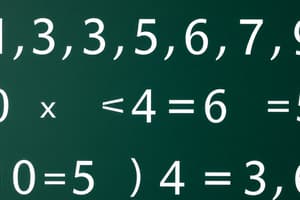Podcast
Questions and Answers
What is the set of numbers that includes natural numbers, whole numbers, and integers?
What is the set of numbers that includes natural numbers, whole numbers, and integers?
- Real numbers (correct)
- Irrational numbers
- Rational numbers
- Complex numbers
What operation is represented by the symbol ^?
What operation is represented by the symbol ^?
- Division
- Exponentiation (correct)
- Subtraction
- Addition
What is the term for a statement with an equal sign, such as 2x + 3 = 5?
What is the term for a statement with an equal sign, such as 2x + 3 = 5?
- Term
- Expression
- Inequality
- Equation (correct)
What is the term for a set of points extending infinitely in two directions?
What is the term for a set of points extending infinitely in two directions?
What type of data consists of numerical values?
What type of data consists of numerical values?
What is the concept of limits in calculus?
What is the concept of limits in calculus?
What is the definition of derivatives in calculus?
What is the definition of derivatives in calculus?
What is the type of integral that has a specific upper and lower bound?
What is the type of integral that has a specific upper and lower bound?
Flashcards are hidden until you start studying
Study Notes
Numbers and Operations
-
Types of numbers:
- Natural numbers (1, 2, 3, ...)
- Whole numbers (0, 1, 2, 3, ...)
- Integers (..., -3, -2, -1, 0, 1, 2, 3, ...)
- Rational numbers (fractions, decimals, percentages)
- Irrational numbers (non-repeating, non-terminating decimals)
- Real numbers (all rational and irrational numbers)
- Complex numbers (imaginary and real parts)
-
Operations:
- Addition (+)
- Subtraction (-)
- Multiplication (×)
- Division (÷)
- Exponentiation (^)
- Roots (√)
Algebra
-
Variables and expressions:
- Variables (letters or symbols representing unknown values)
- Constants (numbers)
- Terms (variables, constants, or products of variables and constants)
- Expressions (combinations of terms)
-
Equations and inequalities:
- Equations (statements with equal signs, e.g., 2x + 3 = 5)
- Inequalities (statements with greater than, less than, or equal to signs, e.g., 2x - 3 > 2)
Geometry
-
Points, lines, and planes:
- Points (locations in space)
- Lines (sets of points extending infinitely in two directions)
- Planes (flat surfaces extending infinitely in all directions)
-
Angles and measurements:
- Angles (formed by two rays sharing a common endpoint)
- Types of angles (acute, right, obtuse, straight, reflex)
- Measurements (length, area, volume, perimeter)
Data Analysis and Statistics
-
Types of data:
- Quantitative data (numerical values)
- Qualitative data (non-numerical values, e.g., categorical, descriptive)
-
Graphs and charts:
- Types of graphs (bar, line, pie, scatter, histogram)
- Uses of graphs (displaying data, identifying patterns, making predictions)
Calculus
-
Limits:
- Concept of limits (approaching a value, but not necessarily reaching it)
- Rules of limits (sum, product, chain rule)
-
Derivatives:
- Definition of derivatives (rate of change, slope of tangent line)
- Rules of derivatives (power rule, product rule, quotient rule)
-
Integrals:
- Definition of integrals (accumulation of quantities, area under curves)
- Types of integrals (definite, indefinite)
Numbers and Operations
- Natural numbers start from 1 and go up to infinity.
- Whole numbers include 0 and all natural numbers.
- Integers include all whole numbers and their negative counterparts.
- Rational numbers can be expressed as fractions, decimals, or percentages.
- Irrational numbers have non-repeating, non-terminating decimals.
- Real numbers encompass all rational and irrational numbers.
- Complex numbers have imaginary and real parts.
- Addition, subtraction, multiplication, and division are the four basic arithmetic operations.
- Exponentiation is denoted by the caret symbol (^) and represents repeated multiplication.
- Roots, denoted by the radical symbol (√), represent the opposite operation of exponentiation.
Algebra
- Variables are letters or symbols representing unknown values.
- Constants are numbers.
- Terms can be variables, constants, or products of variables and constants.
- Expressions are combinations of terms.
- Equations are statements with equal signs, such as 2x + 3 = 5.
- Inequalities have greater than, less than, or equal to signs, such as 2x - 3 > 2.
Geometry
- Points are locations in space.
- Lines are sets of points extending infinitely in two directions.
- Planes are flat surfaces extending infinitely in all directions.
- Angles are formed by two rays sharing a common endpoint.
- Angles can be acute (less than 90°), right (90°), obtuse (greater than 90°), straight (180°), or reflex (greater than 180° and less than 360°).
- Measurements include length, area, volume, and perimeter.
Data Analysis and Statistics
- Quantitative data consists of numerical values.
- Qualitative data consists of non-numerical values, such as categorical or descriptive data.
- Bar graphs display categorical data, while line graphs display trends over time.
- Pie charts show proportions of a whole, and scatter plots show relationships between variables.
- Histograms display the distribution of continuous data.
Calculus
- Limits allow us to analyze how functions behave as the input approaches a certain value.
- The sum, product, and chain rules are properties of limits.
- Derivatives measure the rate of change or slope of a tangent line.
- The power rule, product rule, and quotient rule are used to find derivatives.
- Integrals calculate the accumulation of quantities or area under curves.
- Definite integrals have upper and lower bounds, while indefinite integrals do not.
Studying That Suits You
Use AI to generate personalized quizzes and flashcards to suit your learning preferences.




